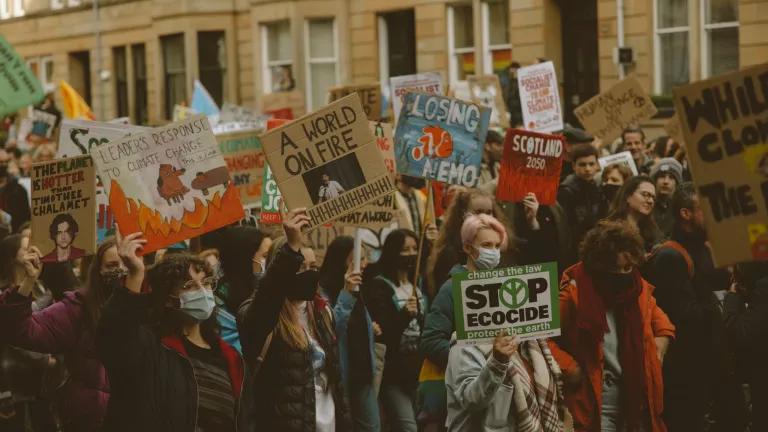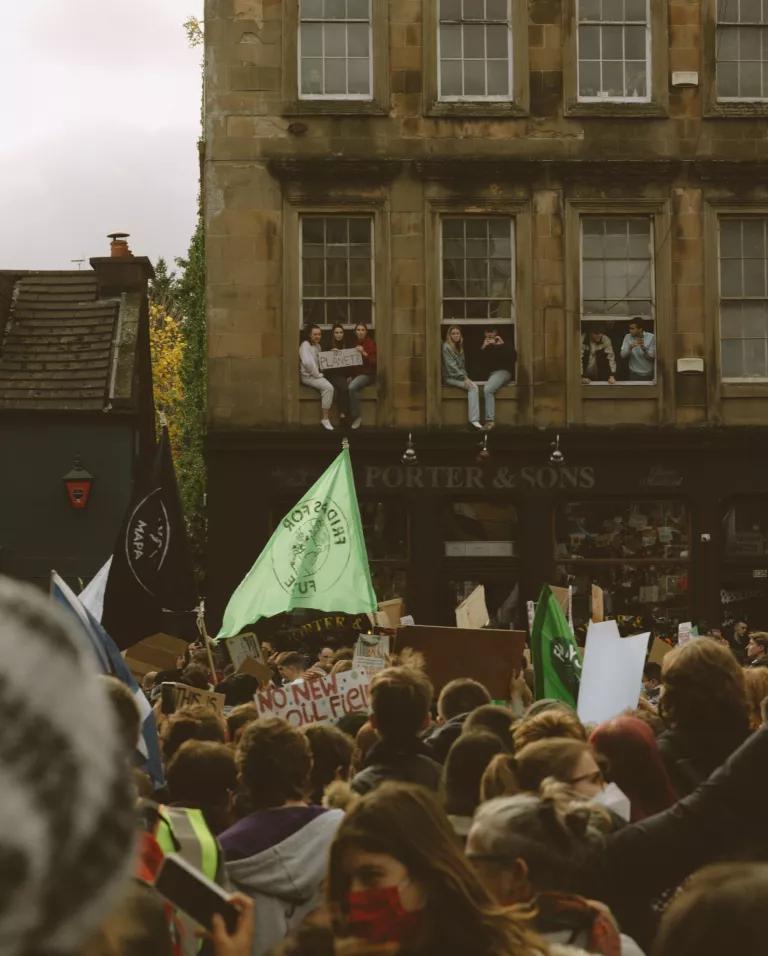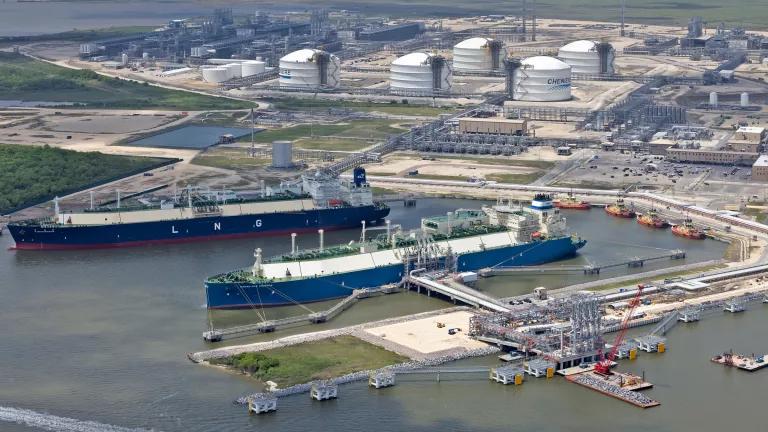Beyond COP26: How Young People Can Bring Climate Action Home
Our generation will be among the most impacted by the decisions made in Glasgow. But there are 353 days out of the year that aren’t COP—and how we choose to seize them will be the true mark of success for the climate action needed this decisive decade.

A large crowd of young protesters with signs crowd a street in Glasgow on November 6, 2021
Our generation will be among the most impacted by the decisions made in Glasgow. But there are 353 days out of the year that aren’t COP—and how we choose to seize them will be the true mark of success for the climate action needed this decisive decade.
Over the past two weeks, heads of states, academics, business leaders, and activists convened in Glasgow, Scotland for the 26th Conference of Parties (“COP26”) to report on the international community’s 5-year progress towards the commitments outlined in the Paris Agreement. As a group of fellows starting out in our climate and energy policy careers, we spent our time in Glasgow hearing from leaders in the climate movement advocate for change across all sectors of society: from fashion executives to building architects; from government officials to youth activists mobilizing their followers on TikTok.
Many people expressed frustration around the levels of ambition—or lack thereof—of developed nations’ commitments. Indeed, the national commitments made at COP26 fall short of the trajectory needed to limit warming to 1.5-degrees. For young people, especially those too young to vote or hold positions of power, there is a growing fear that our fates will be decided by a small handful of the world’s rich and powerful. Yet, we leave Glasgow empowered and hopeful.
Change is not limited to commitments made at the global level, and certainly not to a single international meeting. City and state governments, universities, businesses, financial institutions, community organizations, and nonprofits can all make choices that ripple into systemic changes. As our generation begins to take on roles in these organizations, we have the power to transform the world under our own terms. As Greta Thunberg once told global leaders, “A change is coming—whether you like it or not.”
What happened at COP26?
In some respects, COP26 saw a rise in global ambition to combat climate change. The U.S. and China pledged to work together to limit warming below 2 degrees Celsius, around 450 major financial institutions committed to carbon neutrality by 2030, and approximately 100 nations agreed to cut methane emissions 30 percent by 2030.
At the same time, these commitments are not enough.
Countries’ commitments are currently not on track to meet the critical 1.5-degree warming threshold, and developed economies failed to deliver on the $100 billion a year pledged to developing nations to reduce emissions and adapt to climate change.

Young people with a sign that says “No Planet B” sit in a second floor windowsill overlooking a crowd of protesters in Glasgow on November 6, 2021
Through it all, young people in Glasgow and around the world refused to be sidelined. Inside and outside negotiation rooms, young people rallied for climate justice during COP26. They flooded the streets of Glasgow—in pouring rain—in some of the largest climate marches in history. They organized, campaigned, and advocated on behalf of younger generations to hold leaders accountable to keeping the 1.5 degrees warming target alive.
The young people we met in Glasgow, in addition to the millions around the world who voiced their support on social media, showcase the willpower and capacity of our generation to push for effective climate action. But COP26 is far from the only avenue for change. From within our own communities and organizations, we can drive the progress needed this decisive decade.
Implementation happens at home.
While global commitments are essential for raising the bar of climate ambition, they rely on legislative, economic, and technological steps to carry them out. Implementation does not happen in negotiation rooms—it happens at home: in neighborhoods, cities, and states. Climate progress will only be realized by local action: the true success of COP depends on how we mobilize capital, resources, and policy efforts to execute on climate action now that COP is over.
We have the tools we need to prevent the worst impacts of climate change. Experts’ roadmaps chart multiple pathways to decarbonization across every sector. Executing these roadmaps often falls on the shoulders of unsung heroes: city council representatives, public utility commissioners, state legislators and more. Mitigating and adapting to climate impacts means changing building codes, zoning laws, efficiency standards, and budget allocations. It means scaling solutions that are technologically feasible and cost-effective: transitioning to renewable energy, electrifying the homes we live in and the cars we drive, and adopting regenerative agriculture practices, to name a few. As we learned during the Paris Agreement, national commitments must be the “floor, not the ceiling” of climate ambition—and so it falls on our local leaders to raise this ceiling and keep a 1.5-degree future alive.
In the US, cities and states have led the way in achieving profound climate wins. Twenty-eight states and over 425 cities have released climate action plans to chart their own paths to net-zero emissions in the coming years. Twenty-nine states have passed renewable portfolio standards, leading the clean energy transition by expanding the integration of renewables into our electric grid. Another 16 states have passed zero-emission vehicle standards, limiting pollution from cars and trucks. Twenty-six states have adopted mandatory energy efficiency resource standards, mitigating energy waste and pollution in our built environment. And at the city level, over 400 cities are collaborating in EV purchasing programs and another 125 cities have 100% clean energy pledges. As these policies are not “one size fits all,” it will take individuals in regions across the world to tailor equitable climate solutions to the needs of their community, maximize their co-benefits, and envision a better collective future.
The Power of Young Voices
Young people have pushed climate change to the forefront of the global discourse through school strikes and marches at scales impossible to ignore. As new generations enter the voting and working populace, we can leverage this newfound power to directly influence change across all sectors of society. The burden of solving climate change should not fall on individuals or lifestyle choices alone, but we can each have a role in championing climate action within our own contexts.
Engaging in local decision-making
First, our power lies in our voices and in our vote, especially in local elections and decision making processes. As aforementioned, local leaders are responsible for turning abstract commitments into concrete action. Despite their importance, local elections across the country see extremely low rates of voter turnout, and many city council meetings and public comment periods often go unnoticed. Some great ways to start making change locally are getting informed about local issues, advocating for climate action through public comment periods and phone calls to representatives, and voting in local elections where the majority of on-the-ground implementation occurs.
Mobilizing through our work
As our generation enters the workforce, we can also use our professional capacities to further realize climate commitments through direct action. The timing has never been more promising: from technology to fashion, environmental and social responsibility are increasingly taking center stage across board rooms. The interdisciplinary nature of the climate crisis means that all industries have an opportunity—if not a responsibility—to reduce greenhouse gas emissions.
As we saw with the global community’s response to the pandemic, responding to the climate crisis requires an unprecedented mobilization of effort across all sectors of society. Achieving the emissions reductions necessary over the next few decades will, figuratively, take a village. The world needs technicians to install and service clean energy projects. We need investors to finance new decarbonization technologies. We need urban planners and architects to integrate electrified transit and buildings into our cities. We need storytellers and educators to communicate climate science and process the challenges and opportunities ahead. And we need policymakers and experts collaborating to design and implement policies that drive climate action across all levels of government.
As young people entering the workforce, we are presented with a unique opportunity to align our professional interests with our environmental and social values. We know that there is a better world beyond business as usual. As COP concludes, there is no shortage of opportunities at the civic and organizational level to reclaim our own agency in the fight against climate change. Increasingly, our generation will be able to build climate solutions, influence organizational change, and lead communities through the climate crisis. Our generation will be the climate leaders of tomorrow.
Hope is a necessary ingredient for success.
It’s important to be clear-eyed about the scale of the challenge we face and acknowledge the present-day suffering of frontline communities who are already bearing the brunt of climate change. Communities in the Global South and indigenous communities continue to be the most impacted despite contributing the least to historic emissions and stewarding the majority of the world’s biodiversity. That said, to cite the last five years as wholesale failure erases the labor of generations of activists that have been working tirelessly to accelerate climate action. It is because of these activists that climate change is at the forefront of the global discourse today. Achieving a 1.5-degree future depends on us believing that we can get there.
Even where countries’ ambitions are not enough, there is still reason to hope: the technological and economic barriers to solutions continue to fall at a pace inconceivable even two decades ago. Today, we are lacking only in political will. To quote Christina Figueras of the United Nations, our optimism, “is not the result of an achievement, it is the necessary input to meeting a challenge... I say, ‘we don’t have the right to give up or let up.’” The world we will someday lead is being crafted as we speak. Engaging in climate action is our opportunity to rebuild it in a way that is healthier, more sustainable, and just—for our generation and for future ones. Hope and action are the only way forward.





